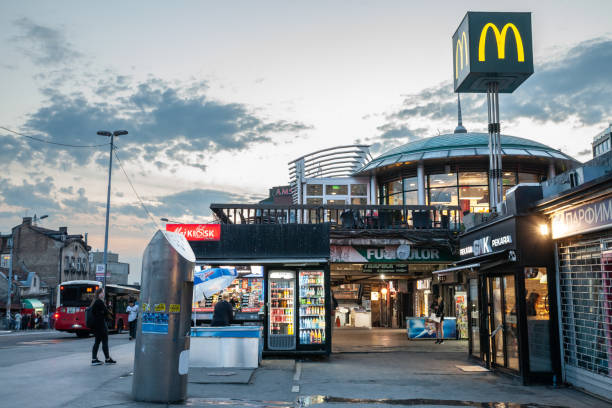
McDonald’s Corporation, a global leader in the fast-food industry, has maintained a dominant position through its extensive reach, strong brand identity, and strategic initiatives. This market analysis examines McDonald’s competitive position by exploring its strengths, weaknesses, opportunities, and threats (SWOT analysis), as well as comparing it with key competitors in the industry.
Strengths
Brand Recognition and Loyalty
McDonald’s boasts one of the most recognizable brands worldwide. Its iconic Golden Arches symbolize fast, convenient, and consistent quality food.
Key Aspects:
- Global Presence: Operating in over 100 countries with more than 39,000 locations.
- Strong Brand Loyalty: A vast customer base with high repeat business due to brand loyalty and familiarity.
Extensive Menu and Innovation
McDonald’s continuously evolves its menu to meet changing consumer preferences, maintaining a competitive edge.
Menu Innovation:
- Diverse Offerings: Wide range of menu items catering to various tastes and dietary preferences.
- Limited-Time Offers (LTOs): Regularly introducing LTOs to create excitement and attract new customers.
Operational Efficiency
McDonald’s has optimized its operations to ensure efficiency and consistency across its global network.
Operational Strategies:
- Franchise Model: Leveraging franchisees to expand rapidly with lower capital expenditure.
- Supply Chain Management: Efficient supply chain ensuring consistent quality and cost control.
Digital Transformation
Investing in digital technologies has enhanced McDonald’s customer experience and operational efficiency.
Digital Initiatives:
- Mobile Ordering and Payment: Advanced mobile app for convenient ordering and payment.
- Self-Service Kiosks: Implementing kiosks to streamline ordering and reduce wait times.
- Delivery Services: Partnering with third-party delivery platforms to expand reach.
Weaknesses
Health and Nutrition Perception
McDonald’s has faced criticism over the healthiness of its menu, which can affect its brand image.
Challenges:
- Public Health Concerns: Negative perception related to high-calorie, high-fat, and high-sugar menu items.
- Regulatory Scrutiny: Increased regulatory scrutiny on nutritional content and marketing practices.
Dependency on Franchisees
While the franchise model provides scalability, it also presents challenges in maintaining consistent quality and service.
Operational Challenges:
- Quality Control: Ensuring uniform quality and service standards across all franchise locations.
- Franchisee Relations: Managing relationships and conflicts with franchisees.
Market Saturation
In mature markets, McDonald’s faces saturation, limiting growth opportunities.
Growth Limitations:
- Limited Expansion: Fewer opportunities for new store openings in highly penetrated markets.
- Intense Competition: Facing stiff competition from other established fast-food chains.
Opportunities
Healthier Menu Options
Increasing consumer demand for healthier food options presents an opportunity for McDonald’s to innovate and expand its menu.
Health Initiatives:
- Menu Diversification: Introducing more salads, plant-based options, and low-calorie meals.
- Nutritional Transparency: Providing clear nutritional information to help customers make informed choices.
Global Expansion
Emerging markets offer significant growth potential for McDonald’s.
Expansion Strategies:
- New Market Entry: Targeting countries with growing middle classes and urbanization.
- Localized Menus: Adapting menu items to local tastes and preferences.
Technology Integration
Continued investment in technology can further enhance McDonald’s competitive position.
Tech Innovations:
- Artificial Intelligence (AI): Using AI for personalized marketing and efficient supply chain management.
- Automation: Implementing robotics and automation in kitchens to improve efficiency and reduce costs.
Sustainability Initiatives
Adopting sustainable practices can enhance McDonald’s brand image and meet consumer expectations.
Sustainability Focus:
- Eco-Friendly Packaging: Transitioning to recyclable and compostable packaging.
- Sustainable Sourcing: Committing to responsibly sourced ingredients and reducing environmental impact.
Threats
Intense Competition
The fast-food industry is highly competitive, with numerous players vying for market share.
Competitive Pressure:
- Price Wars: Intense competition leading to price wars and margin pressures.
- Innovative Rivals: Competitors innovating rapidly to attract customers.
Economic Uncertainty
Economic fluctuations can impact consumer spending and McDonald’s profitability.
Economic Risks:
- Recession Impact: Reduced consumer spending during economic downturns.
- Currency Fluctuations: Adverse effects of currency fluctuations on international revenue.
Regulatory Challenges
Increasing regulations in different markets pose a threat to McDonald’s operations.
Regulatory Threats:
- Health Regulations: Stricter regulations on nutritional content and marketing practices.
- Environmental Regulations: Compliance with environmental laws and sustainability standards.
Competitive Comparison
Key Competitors
McDonald’s faces competition from several major fast-food chains, including Burger King, Wendy’s, Starbucks, and Yum! Brands (KFC, Taco Bell, Pizza Hut).
Competitive Analysis:
- Burger King: Known for flame-grilled burgers, Burger King competes directly with McDonald’s core menu items.
- Wendy’s: Emphasizing fresh ingredients and made-to-order meals, Wendy’s appeals to health-conscious consumers.
- Starbucks: Competes in the breakfast and coffee segments, attracting a similar customer base.
- Yum! Brands: With a diverse portfolio, Yum! Brands offers varied cuisines, competing in multiple fast-food categories.
Market Positioning
McDonald’s maintains a strong market position through its extensive network, brand loyalty, and strategic initiatives.
Strategic Advantages:
- Global Reach: Unmatched global presence providing economies of scale.
- Brand Strength: Strong brand equity and customer loyalty.
- Operational Excellence: Efficient operations and robust supply chain management.
Conclusion
McDonald’s competitive position is strengthened by its global presence, strong brand recognition, and continuous innovation. However, the company must navigate challenges such as health perceptions, market saturation, and regulatory pressures. By leveraging opportunities in technology, global expansion, and sustainability, McDonald’s can enhance its market position and drive long-term growth. Understanding these dynamics helps stakeholders evaluate McDonald’s strategic direction and investment potential.